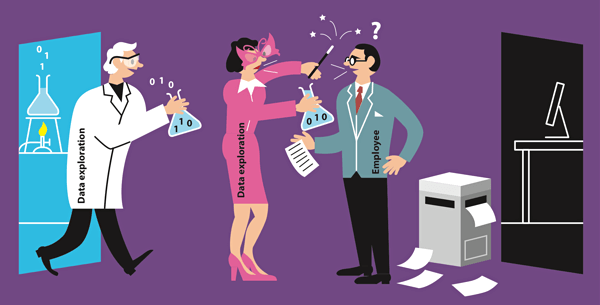The interaction model between information consumers and information producers (3/5)
In the previous article, five use patterns for information were introduced. How you use information differs per pattern. This influences how the information consumers and the professionals who are preparing the information work together. Before I go into how the interaction unfolds, I would first like to prevent any confusion by defining some terms.

The responsibilities of information consumers and information producers
Information valorisation is the task of information consumers. This means that information consumers turn the information into activities and decisions, which deliver value to the organisation. They do something with the information, whether or not in discussion with others.
Information producers are the people who prepare and interpret that information. This is an entire group of data professionals: business analysts, data analysts, information analysts, data scientists, data model designers, specialists in visualising information, ETL specialists, integration specialists and database specialists. Information producers supply information consumers with information and interpretations of that information.
Valorisation depends on how you understand what the information means. Meaning [http://www.b-eye-network.com/blogs/devlin/archives/2013/09/information_kno.php], interpreting the information, is the result of discussions between people. It is seldom the case that an information consumer and producer are one and the same person, except in very small organisations. In larger organisations, the roles are separated along functional lines.
As a result, this leads to a transfer process. What form that transfer process takes, differs according to the use pattern. The consequence is that many misunderstandings can occur during the transfer process, which reduce the potential results of the information valorisation.
The interaction between information consumers and information producers
The interaction between consumers and producers is often a process chain. Not everyone has the skills required to work with data. People with various skills are put together to produce information and they need to be able to make it possible for the information consumers to gain as much value as possible from the information. Organising how consumers and producers work together is of great importance for minimising information loss during the transfer process. For me, Agile working methods have proved themselves as being the most effective collaboration methods in practice.
The type of use pattern ensures that the interaction within the collaboration works differently each time. This doesn’t directly have to do with the mutual communication when working together, but has more to do with everyone’s responsibilities.
Monitoring
Monitoring information is pre-defined. Examples are control rooms in the process industry, business process monitoring (BPM), solutions in ERP systems and traffic information signs above motorways.
The norms and tolerances of the operational processes are clear. The information producer is often the supplier of an ICT system supporting the operational process. If an organisation is itself in charge of production, then the information producers can be found in an ICT- or BI-department.
Information consumers are trained what to do if a deviation is seen in the information; the required action has often already been recorded. The interaction between information consumers and producers is often formal and at a distance. The responsibility for defining and adjusting the norms and tolerances lies with the process owner, who represents all the consumers.
Changes take place via functional application managers who change the configuration of the monitoring, either themselves or by involving their supplier or in-house ICT department. Test processes for changes in the monitoring information are formal.
The interaction model is a formal dividing line between information definition and implementing its use by the information consumers and the technical production of information with transfer via documentation by the information producers.
Accountability Reporting
The best-known form in which accountability information is made available is a management dashboard and the detailed reports which go along with it.
Information consumers are responsible for achieving their contribution to organisational targets. Discussions lead to setting targets beforehand and these are translated into KPIs.
When drawing up and translating KPIs into information solutions, a chain of information producers is involved. Business analysts and data analysts play an important role in making KPIs tangible and sharp, visualising the information is done by specialists to make dashboards as simple and comprehensible as possible, data professionals build complex transformation logic to automate the often numerous KPIs and to deliver information reliably.
When the information shows that it’s necessary to intervene to reach the targets, it’s the responsibility of information consumers to do so. They will be helped in this by the information analysts, who can interpret the information and who help to clarify the consequences of alternative actions in the organisation. Deliberation about which action should be taken is often done through information consumers discussing this amongst themselves, seeking mutual support and making choices together.
Changing information is formalised. Judging the quality of work of information consumers is often linked to the KPIs.
The interaction model is a close collaboration within an information production chain, with a formal assignment of responsibilities in the chain to information consumers.
Analysis
Accountability reporting and analysis are often based on the same set of data and data definitions. The interaction between information consumers and information producers is often a little different, because in analysis you are looking for explanations for deviations or patterns with which to optimise operational processes.
Information analysts include reference data in their analyses, which requires both technical skills as well as insight into operational processes and organisational aims. The analysts interpret the information and communicate their findings to the information consumers. It’s the responsibility of the information consumers to apply the knowledge gained in the analyses.
The emphasis in information use is increasingly being shifted towards ‘self-service’ information products. This doesn’t mean that information consumers themselves are at the wheel in the analyses, but that in the interaction between information analysts and information consumers, consumers are increasingly being taught to find their own explanations for deviations and that information analysts are spending more time gaining new insights from the information.
Within the information production chain, there is a secondary interaction model. Information analysts work closely with data engineers who integrate data from different processes. Their collaboration leads to data and measurement values being uniquely defined and a lot of time is spent in dealing with data quality issues correctly. Managing information definitions and managing information solutions are often formally separated. This means that a lot of attention is needed to prevent the formal division of responsibilities from frustrating the transfer process in the production chain.
Prediction
Prediction is the application of information which is the result of statistical and mathematical models. The emphasis lies on validating the outcomes and calibrating and tuning models against real data to test the predictive strength of the model and thereby the usability of applying the information. Data scientists and other technical data professionals work on preparing data to let the model do its work well.
A model which delivers usable, repeatable predictions, such as predictions when a machine part will need to be maintained, needs to be made operational and the information consumers will need to be taught what they should do with the outcomes.
Often, it is the information consumer who has a business case in which predictions can contribute to an operational process working better or costing less. Using data exploration, it is possible to validate if the model does actually contribute before it is put into production.
The promise of Big Data is that predictive models and business cases will follow automatically from data exploration. Reality shows that it is the other way around. The interaction model requires guidance for the information consumer from the information producers as to what they can expect from predictive models. This demands a lot of empathy on the part of information producers into how information consumers see the world and a down to earth view of what technology can really do on the part of information consumers. Technology can do an impressive amount, but it all starts with clear questions from information consumers.
Data Exploration
Information producers, in the form of analysts or data scientists, are often leading. They search for insights using the available data. These insights are tested for validity and meaning with the information consumers.
Interaction between information producers and information consumers is often on an individual basis. An information consumer, a manager or an information producer, a business analyst, has an idea and would like this tested on reality as expressed in data.
At the same time, automated technical processes are running which are looking for patterns in the data. Validating these requires a lot of insights into both the meaning as well as the results of such technical processes and models as well as understanding operational processes, markets, consumer behaviour or the behaviour of partners in the chain. Bringing this knowledge together requires intensive communication between consumers and producers.
The impact and lead time of information projects
A great deal of the explanation for the duration of information projects is that incorrect interaction models are being applied to an issue. The responsibilities of information consumers and information producers haven’t been clearly defined and there is a lot of miscommunication or lack of understanding about what can be expected from one another. The result is that the value is not harvested because information isn’t being used correctly, or that information production is much too expensive for the value which could be harvested from it.
This conclusion is not a sufficient explanation it itself. There is more at play. Information is not static, but has a context in which it is created or consumed. Context is the source of complexity. The next article in this series will go into this at depth.
